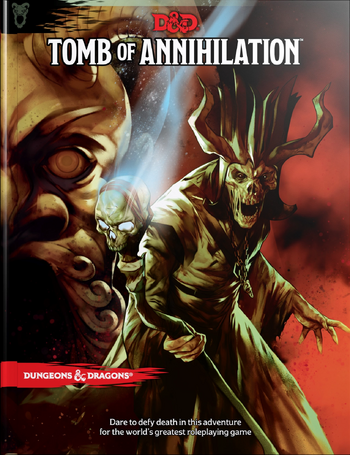
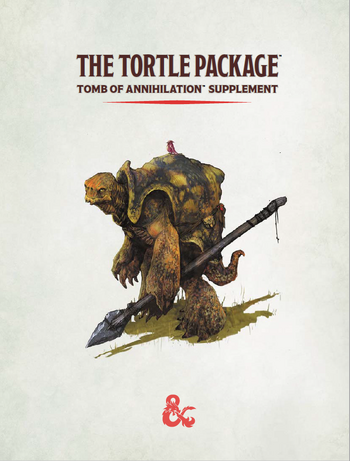


The next part of our little jaunt through D&D 5E's adventure modules and whatnot might be one of my favourites -- the Tomb of Annihilation. Essentially a sequel and a revamp of the infamous 'meat grinder' Tomb of Horrors from the original first edition, Tomb of Annihilation expands the story to encompass not just the titular Tomb of Annihilation but also the island around it. Now I will preface this by saying that, hey, Chult is somewhat problematic of a setting. Not as problematic as it originally was, but still kind of iffy... but I'm not here to discuss about the adventure module anyway, but rather the monsters within. You know me an monsters!
And hey, apparently Tomb of Annihilation got so popular that it got three little 'expansion packs' or DLC's. Granted, Lost Kenku and One Grung Above are more tongue-in-cheek and simpler, but the Tortle Package, in addition to adding the Tortles as a playable race (and got reprinted in... Volo's or Mordenkainen's, I forgot) while adding a little subsection to the setting of Tomb of Annihilation.
Anyway, the actual Tomb of Annihilation game was pretty fun when I played through it, but I think more than anything, the sheer variety of wacky monsters really ended up dragging me in. Among other weirdos we've covered before in Volo's Guide to Monsters, the Bodak, the Froghemoth, the Flail Snail, the Fiewnewt, the Girallon, the Grung and the Vegepygmy are some really notable monsters that made their 5th Edition debut in Tomb of Annihilation.
______________________________________
Tomb of Annihilation
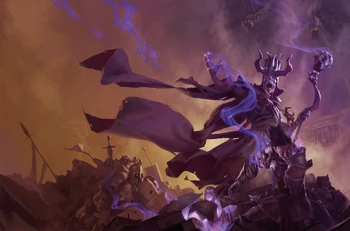
Acererak
Again, I don't really talk too much about the actual evil NPC's of any given adventure module, but I feel like I've always been making an exception for all the final bosses. Tiamat, Strahd von Zarovich, the demon lords, the elemental princes... so yeah, let's talk a bit about Acererak. He's the dude on the cover of Tomb of Annihilation, and he's also, apparently, the cool skeleton man in the cover of the Dungeon Master's Handbook! Originally a Demilich in the very first Tomb of Horrors -- and I think the biggest 'gotcha' was the fact that this skull with gemstones is actually as powerful, if not moreso, than a regular lich; Acererak has apparently been upgraded into an 'Archlich', and he travels between dimensions and timelines (he's like a M:TG planeswalker) to devour powerful souls. His modus operandi is to create giant dungeons filled with traps that will catch unwary adventurers dumb enough to shove their hand into statues with gaping mouths. Acererak's ultimate goal isn't to be a god. That's so blasé. Instead, Acererak is using all the soul energy he's gathered to create a brand-new god. He wants to be a god-daddy. Acererak is kind of a lunatic, and I love him. Design-wise... he's just a pretty boring skeletal wizard-man with a cool helmet, but boy oh boy that sure is a very cool artwork for him, huh? Not a whole ton to say here; mechanically he's kind of a modified lich, a very serviceable end-boss for a dungeon.
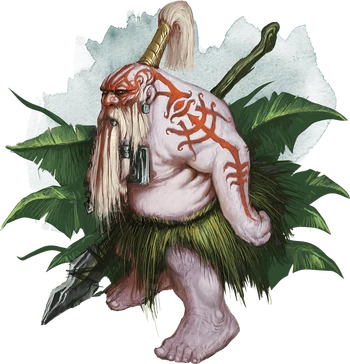
Albino Dwarf
Ehhhhhhh. The Albino Dwarves are like, generic 'outcast' dwarves who live in a tribal setting in the jungles of Chult. It's very cool that they're using the local dinosaurs (Chult is a dinosaur-land and that's like, 90% of the cool factor there). Stronger Albino Dwarves can get spellcasting abilities from local island spirits, becoming a Spirit Warrior. I've personally never cared at all about any race variant that goes 'oh, they're albinos and they are outcasts'.
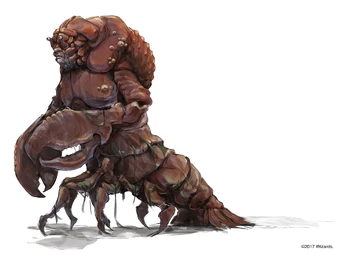
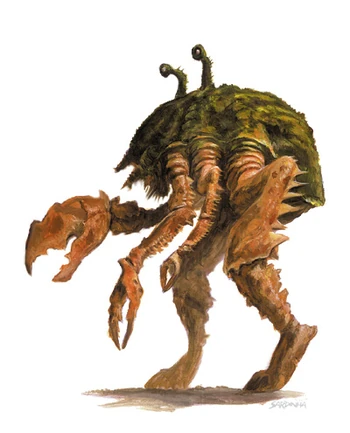
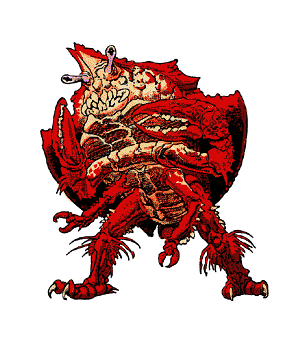
Aldani (a.k.a. Lobsterfolk)
There's just something about lobsters and prawns that are just hilarious. Depending on who you ask, the Aldani, the Lobsterfolk, the Crabfolk and the Yurian are all maybe part of the same monster that just got different names in different iterations of D&D. As we covered in the later-published Mordenkainen's Fiend Folio, though, the Crabfolk are clearly different than the Lobsterfolk because, well, crabs and lobsters aren't even part of the same family! The original 2E description of the Aldani is that they have lobster bodies, two legs, and a strange face. And... that sure is a two-legged strange mutant lobster monster! 3E's Aldani takes things even further with something straight out of a B-movie alien, and I absolutely love the two comical eyestalks above the carapace. That set of two legs and a bunch of giant hideous twisted lobster claws jutting down from a dome is pretty cool, and 3E Aldani looks like some sort of hideous Spiky Flumph monster.
But 5E's Aldani is... it's pretty interesting. It abandons a lot of the bipedal vibe of the first two versions of the Aldani, and instead gives the Aldani the lower body and giant pincers of the lobster... but the general upper body structure similar to that of a human. The result is an interestingly unnerving lobster-centaur man with, what's most disturbing, half of a human face underneath all that chitin. I do really like that. Normally I balk at giving like, bug-men or crustacean-men human faces because bugs and crustaceans always have creepier-looking faces, but in this case I'll make an exception because that artwork is so great at hiding the human nose, mouth and chin encased by the lobster parts... that small feature makes the Aldani look so much more bizarre than something like Magic's Homarids or Warcraft's Makrura. 5E Aldani even still has the eyestalks that its predecessors have, which adds to the unsettling factor!
I haven't really looked up how the Aldani were portrayed in 2E and 3E, but in Tomb of Annihilation they are described as basically a reclusive race -- formerly fishermen that overfished lobsters and got cursed by the god Ubtao -- that hide in their large lake, and they are actually kind and avoid conflict... but are also pretty xenophobic. Hey, just because a monster plays the 'scary but actually timid' card, doesn't mean they can't be assholes! The Aldani, rather hilariously, will try to bribe adventurers with treasures scrounged from the lakebeds to leave them alone. They have a very cool artwork, I must say!
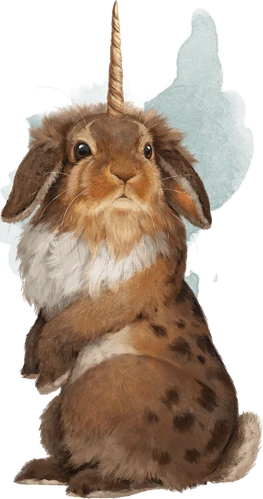
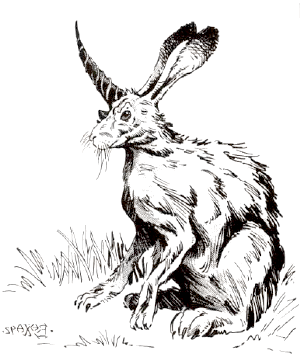
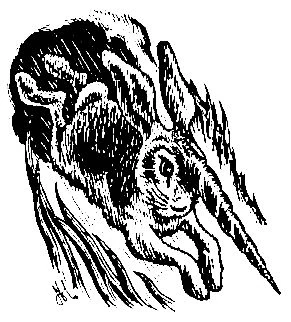
Almiraj
The Almiraj (or Al-Mi'raj) is based on a mythological creature from the Arabic book 'The Wonders of Creation', and supposedly was a magical beast that was gifted by islanders of a mysterious island plagued with a giant serpent (or dragon) to Alexander the Great, who slew the dragon. It's just a bunny with a big-ass unicorn horn! Identified as a fey creature in some editions, for the most part they are just noted to be rabbits with specifically the horn of a unicorn... cute little critters similar to the Tressym from one of the previous adventures that are there begging for players to adopt them as a pet. I do really love how the 5th Edition artwork gave up all attempts at making this thing badass and even used an adorable lop-eared rabbit as the base body instead of the more jacked-up hare of 2E. The actual mythological Almiraj wasn't portrayed as much beyond a curious little beast, so I approve.
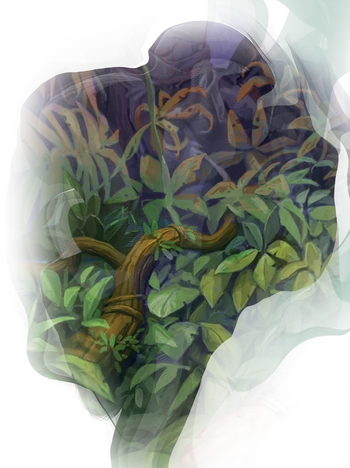
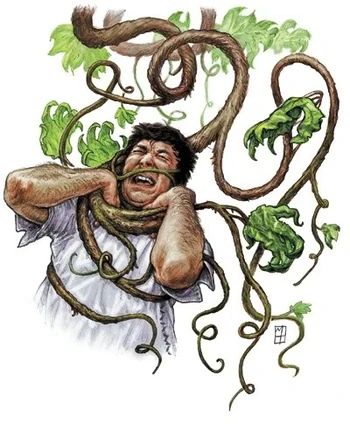
Assassin Vine
I am always of the opinion that Dungeons and Dragons could use a lot more plant monsters. Sure, treants, shambling mounds and blights are cool, but there's like, not a whole ton. Assassin Vines are cool, though! First briefly described as a footnote in 2E before getting artwork in 3E and 5E, the Assassin Vine is simple in that it doesn't look exotic. It's not trying to look like Swamp Thing or whatever. It's just a vine that grabs and crushes any unlucky animals (or humans) that pass through, strangle them to death, and then use their corpse as fertilizer. Sort of like a giant-size version of a venus flytrap or a sundew, but with humans! I do really like this, as visually unremarkable as the Assassin Vine actually is. It's not some cursed plant or ancient nature spirit. It's just a plant that's magically evolved into hunting animals and humans for prey, and otherwise it just looks like any random vine in the forest. I also do like Tomb of Annihilation's description of its grape-like fruit, as well as describing an underground variant that seems to have a symbiotic relationship with a colony of fungi.
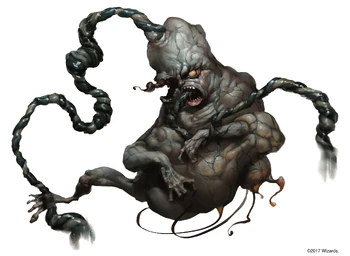
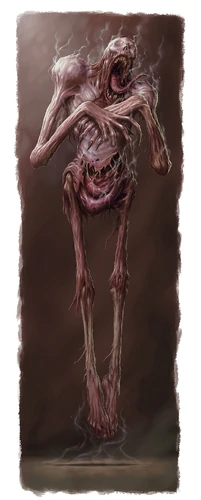
Atropal
Ah, the Atropal. One of the more fucked-up monster concepts, and yet simultaneously also pretty damn cool. See, while the specifics differ between 3E, 4E and 5E, simply put... the Atropal is the undead aborted fetus of an unborn god. Yep! Abortion and undead babies are always topics that are pretty uncomfortable and make for some of the spookiest traditional stories in many cultures. So of course, D&D ends up applying all those terrifying horror tropes... to a god. Which, I'm not going to lie, is actually a pretty cool concept. And I do like how they went along with it. 3E's Atropal plays a lot on the 'baby' part, with the general look being perhaps too close to a real baby... but with a misshapen skull, limbs that taper off, and, of course, that umbilical cord. Pretty spooky, and you can just tell from the proportions that this isn't just your average undead baby.
4E's Atropal is the first one I saw and it's... it's pretty gross looking. I've seen enough spooky fantasy undead monsters (and real life cadavers) to not be grossed out by the visible pelvis and the gaunt flesh clinging on to the bones bent in rigor mortis, but that face is sure a pertty scary one with flesh that just covers the hollow eye sockets and that big, screaming mouth with a tongue lolling out of it. The 'god' part of 4E's Atropal is perhaps a bit more easily communicated, but not so much the 'baby' part... and it's not meant to really be a 'baby' anyway, just a malformed god.
5E's Atropal, on the other hand... yeah, it's got the huge head and the somewhat curled position of a baby. It even has the umbilical cord of the 3E Atropal, albeit one that emerged out of his head and mouth... and I really, really find it cool that the Atropal's baby is genuinely misshapen and turned into this weird protoplasmic sludge filled with misshapen tumours. I especially enjoy that mass of goop where the left leg should be. Because, well, if it's a baby-god (however that works in Forgotten Realms cosmology) the process of god-making is probably not the same with human embryology, right?
Anyway, 5E's Atropal is... interesting as far as the backstory goes. The Atropal here is the unfinished, abandoned creation (there's the abortion part) of an evil god. It's never truly alive, and thanks to the godly part of its creation, the Atropal can't gain life even with divine intervention. So it just lives its non-life, cursing and destroying everything, attached to the Negative Plane which gives its power over death and undeath, using sheer power of will to warp and make the Negative Plane bleed into the normal world via wraiths. Interestingly, a powerful enough weapon can sever the umbilical cord which connects the Atropal to the Negative Plane, which would cut it off from its source of power. Pretty spooky monster, even if it's arguably one that works better visually.
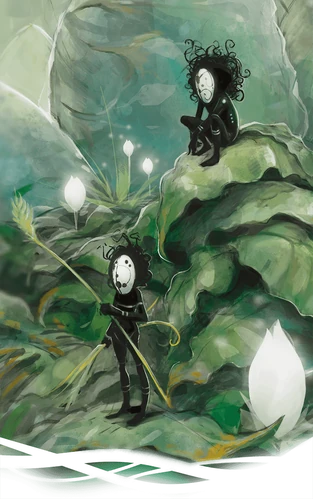
Chwinga
Oh I actually like these little buggers a lot! The Chwinga, loosely based on something like the kodama of Japanese mythology, and they are cute little fellows that are shy, living out of sight from humanity. They look like fey, but are identified by the game world as being tiny elementals. They look cute, being these tiny black humanoids with a tangle of hair surrounding a mask-like face. And the mask has little dots that sort of form a face, but not really... it really does look like something out of a Miyazaki movie or something, I like them. They really do feel like some sort of fey creature, though, with them each claiming a part of nature like a rock or a leaf as their personal shelter, and their arrival being heralded with either breezes, flower scents or fireflies. They are also fascinated with humanoids, although apparently what makes a Chwinga be interested can vary from something like music or cooking to 'hey, this dude combs his hair well!' The Chwinga can cast little cantrips to aid its favoured human, and when it dies it turns into either flower petals, pollen, water or a stone statue of itself. They're cute and a nice little addition of something that's not yet another stat-block for your PC's to hack through or just another NPC to recruit as an ally. I like them.
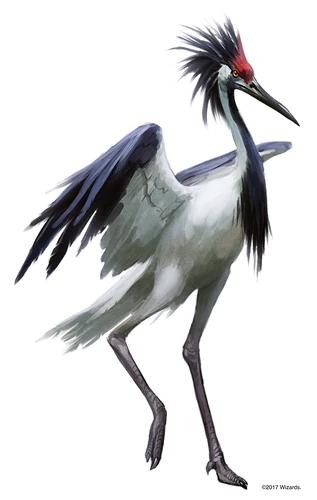
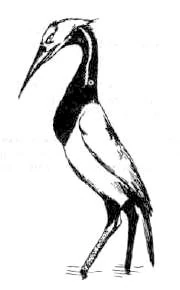
Eblis
I'm not 100% sure if this is taken from any mythology (the wiki says it's taken from Iblis, but the myth is completely different), but the Eblis, while looking like a pretty generic crane, are apparently reincarnations of evil humans. And now they are evil cranes that have the intelligence of humans. Considered as 'monstrosities', and able to speak, the Eblis basically try to sway other creatures to do their bidding, manipulating and tempting them to walk into unfortunate deaths or to fight other creatures that have offended them. Pretty interesting, I suppose, even if visually they are pretty boring.
Flying Monkey
Insert your obligatory Wizard of Oz quote here. The Flying Monkey has a pretty cute artwork of what I think is a capuchin monkey with wings, but ultimately they're just exactly what it says on the tin. A monkey with wings! And they're about as dangerous as a regular monkey in D&D (which is not very unless there's a lot of them) but they can fly. Not much to say here, I do like some of these pretty simple-but-exotic hybrid chimera animals.
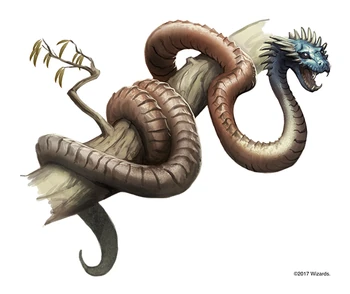
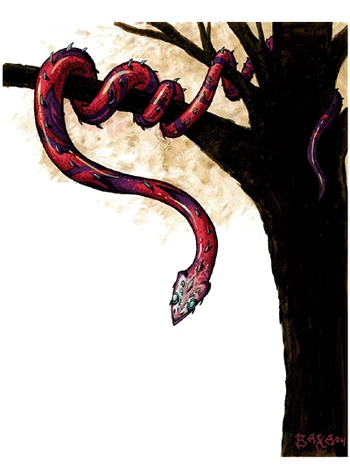
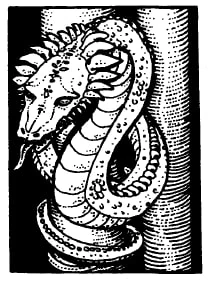
Jaculi
Based on the Jaculus of Greek mythology, the Jaculi is an interesting creature that is basically something involving a simple gimmick based on its inspiration -- it's a snake, but its head is hard and it has the ability to launch itself at its prey like a javelin! Something that, apparently, the Greeks actually used in warfare. Snake javelins! D&D's Jaculi has shown up in various editions as a minor little monster (and I like the spearheaded 3E artwork very much) and in 5E, it's even gotten some chameleon-esque ability to alter its colour and texture to camouflage itself to resemble wood and stone. Pretty hilarious monster! I do like this one. A simple concept, and one that lends itself very well as a tabletop RPG enemy.
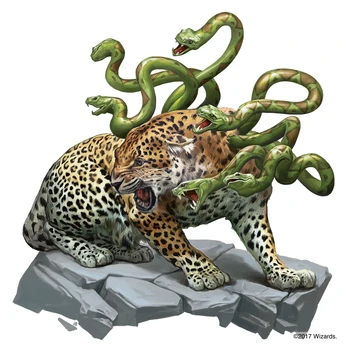
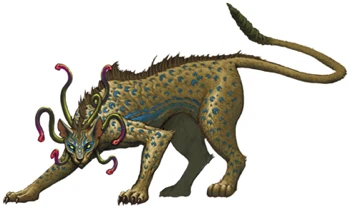
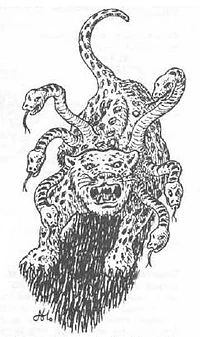
Kamadan
This one is not from mythology, but rather just one of the many, many crazy motherfuckers that debuted in the first edition Fiend Folio. It's honestly a pretty fun little monster concept, just a big scary leopard with a bunch of venomous snakes growing out of its neck like a little frill. Honestly, it could've fooled me into thinking that it's something from actual real-life mythology. And in addition to being a leopard with venomous snakes, the Kamadan, for whatever reason, is also able to breathe sleeping gas. I'm not sure what part of the fusion between a leopard and snake leads to the ability to induce narcolepsy, but okay, sure. I do like the little detail noting that it's a bit of an argument for sages on whether Kamadans are actually related to Displacer Beasts or not.

Mantrap
A Mantrap is a giant Venus Flytrap. Not quite as memorable of a silhouette as Mario's Piranha Plants or Zelda's Deku Babas, but still, it's a giant venus flytrap! The Mantraps' flower-jaw; at least from this 1E artwork, act more like a bear trap on the ground as opposed to a fanged head on a snake-like stalk... which kinda-sorta makes sense, I guess? The Mantrap also releases magic pollen that draws creatures to it. Again, a pretty neat and simple plant enemy!
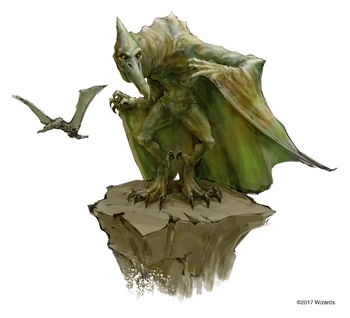
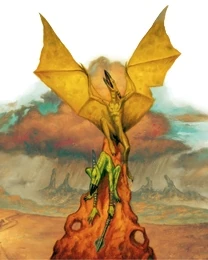
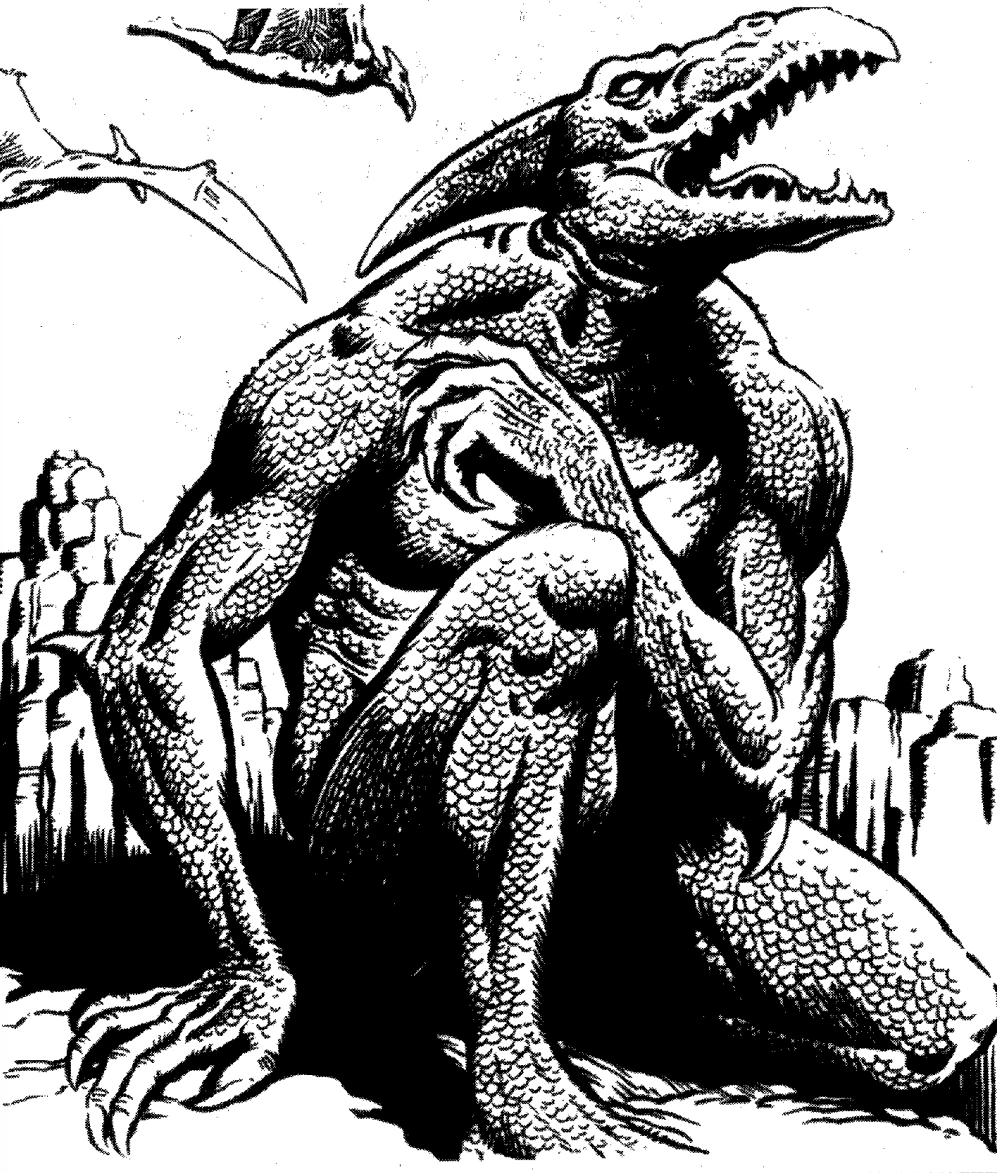
Pterafolk
Oh shit, it's Sauron! No, not the big floating eyeball from Tolkien's works, but the far cooler X-Men enemy. See, one of the most interesting thing about Chult is that it's actually home to a whole ton of dinosaurs, with a real The Lost World vibe going on here. Personally I've always felt like there really isn't any reason to segregate dinosaurs into a single island when the rest of the Forgotten Realms is filled with Greek monsters and Carrion Crawlers and Bullettes and dragons anyway, but for some bizarre reason, real-world extinct creatures is something that D&D is kind of ashamed to include in their totally-nowhere-close-to-a-Middle-Ages-setting? Eh. At least 5E is a bit better at it.
What's there to say about the Pterafolk, their design is quite literally Sauron. Or, well, if you prefer, a Harpy but with a Pteranodon instead of a bird. 5E Pterafolk lacks the palaeontologically-inaccurate teeth of 2E Pterafolk and the bat-wing-fingers of 3E Pterafolk, and I do appreciate that. Pterafolk are basically these primitive, sentient race that raids the local Chult people, kidnapping treasure, food and captives to their clifftop roosts. In previous editions, Pterafolk could transform into actual Pteranodons or into regular Lizardfolk all lycanthrope-style, but apparently by the time 5E rolled around these rituals are 'long lost'. A neat little nod to the history of this creature in older editions.
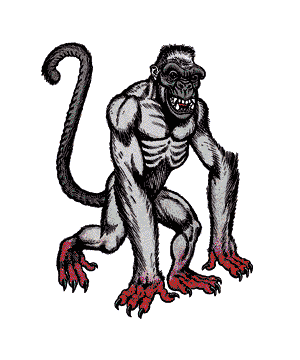
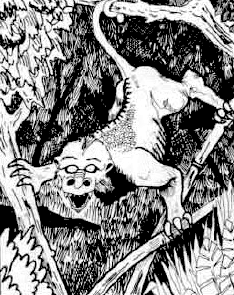
Su-Monster
The Su-Monster have been around since the very first Monster Manual, and is also a creature that I find to be terribly underwhelming. They're like, slightly-larger monkeys with psionic powers for some reason? And they sleep upside-down like bats, and will drop down and tear people apart with their massive claws? Psychic rabid monkeys are neat, I guess, and I really do like the 5E artwork for really giving the creature a ghoulish face that highlights how terrifyingly rabid monkeys can be, but ultimately it's always a monster that I find to be somewhat underwhelming.
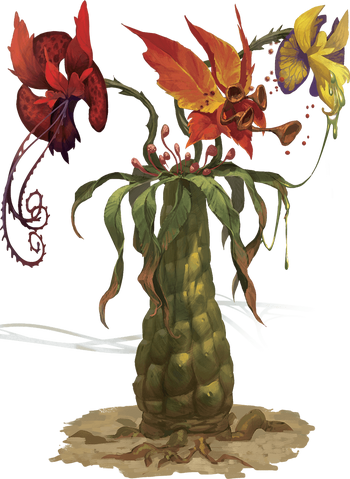
Tri-Flower Frond
More plant monsters! This one is cute, having a little stumpy stem that would grow exactly three threatening flowers, each with little trumpet-like attachments that can harm any passing humanoid -- the orange flower has a sleeping poison; the yellow flower has corrosive acid and the red one has grappling vines. Kinda weird, and perhaps a bit too video-game-enemy-esque in how specific it is, but I do like the attempt at world-building with weird plants!
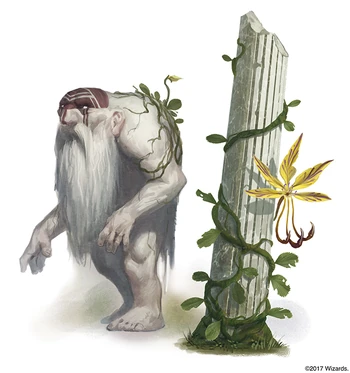
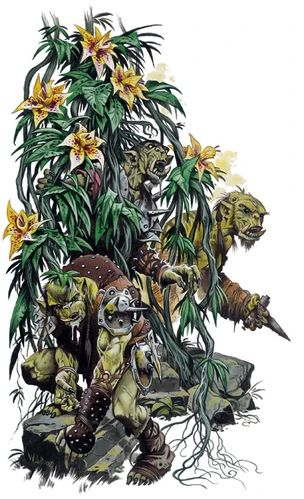
Yellow Musk Creeper
Another one that appeared in the Fiend Folio, the Yellow Musk Creeper is a pretty damn cool plant monster, and perhaps one of the more threatening ones compared to the Mantraps and Assassin Vines in the book. See, the Yellow Musk Creeper is just a weird, somewhat orchid-like flower that outwardly resembles a regular creeping plant. But it's actually some Resident Evil style plague, striking any humanoid that wanders nearby and turning them into a zombie by implanting bulbs within their bodies. The bulbs would turn into vines that wrap around the corpses of its victims, animating them like a zombie, before turning into a yellow creeper vine itself. The zombies will protect its parent plant, while also simultaneously becoming fertilizer for the little Yellow Musk Creeper baby within its own body... which would, of course, consume the corpse as it grows into its own adult plant. And any fans of biology (or of Pokemon) would recognize this as being pretty much an upscaled version of the parasitic fungus Cordyceps. I'm not sure how much of the actual zombie fungus inspired the Yellow Musk Creeper's initial conceptualization, but it sure is pretty similar and the addition of actual zombie tropes does make it pretty fun. Definitely one of my favourite plant enemies, a lot more insidiously threatening.
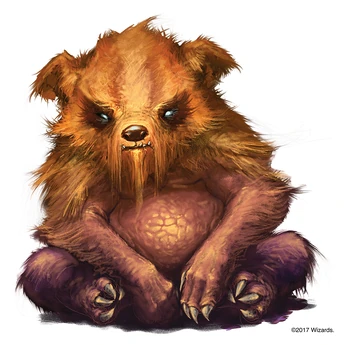
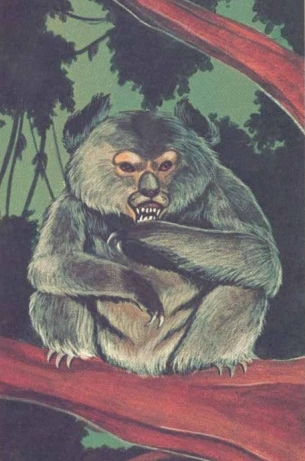
Zorbo
It's a Zorbo. It's... originally a koala, but now it's a cool Ewok? Or a feral koala? Zorbos are, despite their otherwise cute look, actually carnivorous, ferocious and is explicitly noted to have a fondness for humanoid flesh. It's also got some bizarre magical properties allowing it to weaken and destroy armour, while also being able to alter its own flesh to match its surroundings. This little angry koala is surprisingly terrifying, and I'm all up for it! It's like a Displacer Beast, only instead of looking like a giant turtle-insect terror, it disarms you by looking like a cute koala baby.
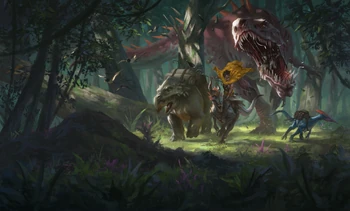
Zombie Variants
We're almost done with the base Tomb of Annihilation books, but we do have a bunch of extra little variant monsters which, I feel, are way more interesting than any of the previously-published adventures. The zombie variants are, well, interesting because of just how much more interesting fighting a giant Girallon zombie or dinosaur zombies (T-REX ZOMBEE) are compared to 'zombie with magic' and 'zombie in armour'. Hell, it even fits the combination of the themes of Acererak's death-curse and the exotic, King Kong-style secret island of deadly monsters vibe. The artwork for the Girallon Zombie is cool, and I find the Tyrannosaurus Rex zombie actually having a feature to vomit out the corpses it had eaten as little zombie minions to be pretty hilarious.
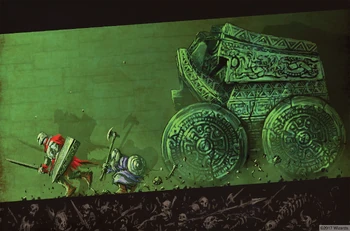
Stone Juggernaut, Giant Four-Armed Gargoyle, Tomb Guardian
I don't really have much to say about them, although they are statted in the game. The Stone Juggernaut is just a giant magic-style tank with giant wheels and basically a mechanical version of the Gelatinous Cube -- it fills up an entire corridor and it will hit-and-run you to death. A pretty cool little variant enemy; we can't all have weird chimeric beasts and creepy plants. The Giant Four-Armed Gargoyle is... exactly what it says on the tin. It's a gargoyle, it's larger than a regular gargoyle, and it's got four arms. Pretty cool artwork. And the Tomb Guardian is just like, a rusty iron golem with chains. Cool cool cool.
___________________________________________
THE TORTLE PACKAGE:
But wait, we're not done! We have an extra bit of expansion for the Chult area, and the Tortle Package, in addition to introducing the Tortles themselves (which are cute turtle-people I covered here) also adds a bunch of extra wacky monsters that reside in the sub-area of the Snout of Omgar. Honestly, between the Tortle Package and Mordekainen's Fiend Folio, I get the feeling that these online-specific PDF's might be a way for them to add in some of the straight-up weirder enemies from older D&D editions. Which, again, I'm all up for.
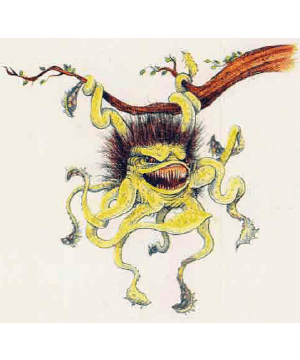
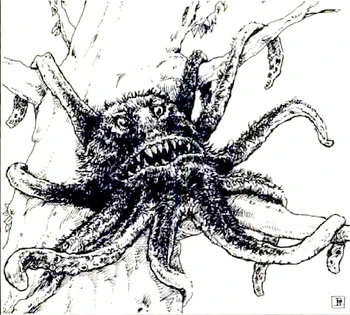
Decapus
Surprisingly a creature that's shown up in multiple editions of D&D, the Decapus, the creature hasn't really changed a whole ton over the years. It's always an octopus with a huge fanged face and ten tentacles that hangs out on treetops. I find the 2E one kind of bizarre with that mop of 70's hair. The 4E Decapus goes for a completely more sinister and serious look, which... I actually don't mind, as ridiculous as the Decapus is, it actually looks kinda menacing there. 5E Decapus is a bit goofier looking, but that completely unhinged-looking lunatic expression on its face makes me feel pretty uneasy when looking at it as well. I do find it funny that the Decapus is noted to be a lot more dangerous when it's attached to a tree -- it only needs one tentacle to support itself so it can decapus-fu you with the other nine; but on the ground it needs at least five limbs to support its body. Pretty simply but wacky creature, I like this one. The Tortle Package also describes a Marine Decapus, which is, well, basically a Decapus sharing the ocean with actual octopi.
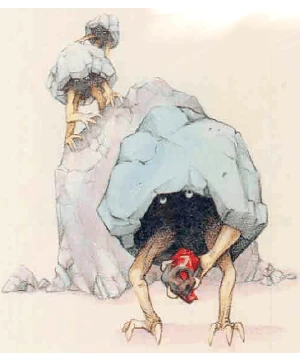
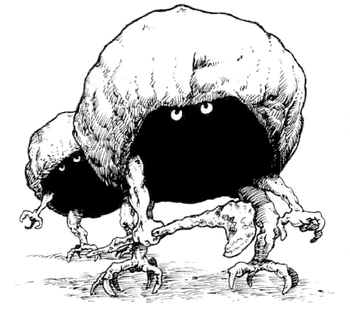
Geonid
Another one that I like a fair bit, the Geonids are apparently also called "Rocklings" or "Rock Hermits". I guess that's what they're based off of? Hermit crabs? The Geonids are elementals that arrive from the Elemental Plane of Earth, sort of like Galeb Duhrs but instead of being fully rock-people, they're huge rocks with a body we're never fully privy to other than gangly arms and two glowing eyes in a dark void. I really like the 5E version the best with the truly gangly arms and the depiction of another one completely in its hermit-crab-shell in the background. They're pretty interesting, and they're noted to be pretty timid, happy to eat small animals and collect gemstones and will hide in their rock-shells.
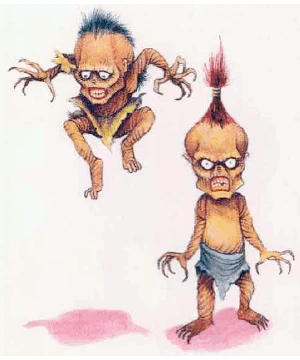
Topi
Speaking of creepy babies... yeah, I'm glad they moved away from the 2E artwork which is kind of perhaps a bit too 'oh savage tribal pygmies' for my tastes. 5E's Topi is apparently a shrunken corpse turned into a zombie, and its heart is replaced with a poisonous snake in a ritual. This gives the Topi poisonous claws because of magic. There's a fair bit of racism regarding the whole 'shrunken corpse' thing that makes me somewhat uncomfortable, but the 5E Topi at least feels somewhat divorced from real-world mythology.
A bit of a shorter one this time around, although it does give me the opportunity to talk a bit longer about the wacky creatures in Chult. The next couple of books are the Waterdeep duology and the Eberron stuff, which would definitely need a fair bit of talking about. Or maybe not. I haven't actually read the Waterdeep books.
_______________________________
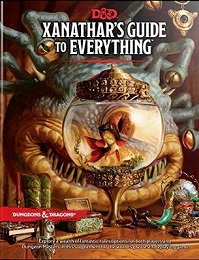
Also released in 2017 is the very useful Xanathar's Guide to Everything, counted among the new 'core' books... but it's apparently Xanathar's Guide to Everything But Monsters, because it added absolutely no new monsters. Boo! Xanathar himself is fun, a Beholder magic-mafia kingpin, and the book is pretty neat, but as far as these 'reviewing monsters' articles are concerned Xanathar's doesn't really add much.
Tomb of Annihilation:
The stats of bodak, brontosaurus, champion, deinonychus, dimetrodon, firenewts, flail snail, froghemoth, girallon, grung, hadrosaurus, elite kobolds, elite yuan-ti, velociraptor, vegepygmy, thorny, stegosaurus and quetzalcoatlus are originally printed here before Volo's Guide to Monsters.
- Acererak: Medium undead; neutral evil; CR 23
- Albino Dwarf Spirit Warrior: Medium humanoid - dwarf; any alignment; CR 1
- Albino Dwarf Warrior: Medium humanoid - dwarf; any alignment; CR 1/4
- Aldani (Lobsterfolk): Medium monstrosity; lawful neutral; CR 1
- Almiraj: Small beast; unaligned; CR 0
- Ankylosaurus Zombie: Huge undead; unaligned; CR 3
- Artus Cimber: Medium humanoid - human; neutral good; CR 7
- Asharra: Medium humanoid - aarakocra; awful neutral; CR 2
- Atropal: Huge undead - titan; neutral evil; CR 13
- Bag of Nails: Medium humanoid; chaotic neutral; CR 8
- Chwinga: Tiny elemental; neutral; CR 0
- Clay Gladiator: Medium construct; unaligned; CR 5
- Dragonbait: Medium humanoid - saurial; lawful good; CR 5
- Eblis: Large monstrosity; neutral evil; CR 1
- Flying Monkey: Small beast; unaligned; CR 0
- Giant Four-Armed Gargoyle: Large elemental; chaotic evil; CR 10
- Giant Snapping Turtle: Large beast; unaligned; CR 3
- Giant Strider: Large monstrosity; neutral evil; CR 1
- Girallon Zombie: Large undead; chaotic evil; CR 3
- Hew Hackinstone: Medium humanoid - dwarf; chaotic neutral; CR 2
- Jaculi: Large beast; unaligned; CR 1/2
- Kamadan: Large monstrosity; unaligned; CR 4
- King of Feathers: Huge monstrosity; unaligned; CR 8
- Liara Portyr: Medium humanoid - human; lawful evil; CR 4
- Mantrap: Large plant; unaligned; CR 1
- Mwaxanare: Medium humanoid - human; lawful neutral; CR 1/8
- Orvex Ocrammas: Medium humanoid - human; neutral; CR 1
- Pterafolk: Large monstrosity; neutral evil; CR 1
- Ras Nsi: Medium monstrosity - yuan-ti shapechanger; neutral evil; CR 7
- Salida: Huge monstrosity - yuan-ti; unaligned; CR 2
- Sekelok: Medium humanoid - yuan-ti; neutral evil; CR 9
- Shago: Medium humanoid - human; chaotic good; CR 5
- Skeleton Key: Medium undead; unaligned; CR 1/4
- Stone Juggernaut: Large construct; unaligned; CR 12
- Su-Monster: Medium monstrosity; chaotic evil; CR 1
- Syndra Silvane: Medium humanoid - human; lawful neutral; CR 12
- Tabaxi Hunter: Medium humanoid - tabaxi; chaotic good; CR 1
- Tabaxi Minstrel: Medium humanoid - tabaxi; chaotic good; CR 1/4
- Terracotta Warrior: Medium construct; unaligned; CR 1
- Tomb Guardian: Medium construct; neutral; CR 6
- Tri-Flower Frond: Medium plant; unaligned; CR 1/2
- Tyrannosaurus Zombie: Huge undead; unaligned; CR 8
- Valindra Shadowmantle: Medium undead; neutral evil; CR 21
- Volothamp "Volo" Geddarm: Medium humanoid - human; chaotic good; CR 1/4
- Withers: Medium undead; neutral evil; CR 4
- Xandala: Medium humanoid - half-elf; neutral evil; CR 7
- Yellow Musk Creeper: Medium plant; unaligned; CR 2
- Yellow Musk Zombie: Medium undead; unaligned; CR 1/4
- Yuan-ti Priest: Medium monstrosity - shapechanger; neutral evil; CR 3
- Zindar: Medium humanoid - half-dragon; lawful good; CR 8
- Zorbo: Small monstrosity; unaligned; CR 1/2
Tomb of Annihilation: The Tortle Package
- Decapus: Large monstrosity; unaligned; CR 4
- Geonid: Small elemental; neutral; CR 1/4
- Giant Slug: Large monstrosity; unaligned; CR 3
- Topi: Small undead; chaotic evil; CR 1/2
- Tortle: Medium humanoid (tortle); lawful good; CR 1/4
- Tortle Druid: Medium humanoid (tortle); lawful neutral; CR 2
- Two-Headed Plesiosaurus: Large beast; unaligned; CR 4
No comments:
Post a Comment